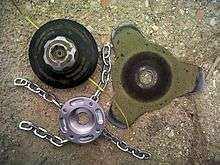Brushcutter (garden tool)

A brushcutter is a powered garden or agricultural tool used to trim weeds and other foilage not accessible by a lawn mower or slasher.
It consists of:
- A power unit held close to the body.
- A pole through which the power is transmitted.
- A rotary cutting head at the opposite end of the pole to the power unit.
Power units
There are three main types of power unit:
- Petrol engines, either two or four stroke, are used on the most powerful units.
- Electric motors connected to mains power by a power cord.
- Cordless electric motors powered by rechargeable batteries.
Shaft
There are three types of shaft:
- Basic consumer units use a curved shaft.
- More professional units use a straight shaft with a gearbox at the cutting head end.
- Top of the line units use a straight "split" shaft with a disconnection point partway along the shaft, allowing the cutting head to be replaced by other accessories such as pole pruners, cultivators, edgers and hedge trimmers.
There is a handle, closer to the power unit than the head, which varies from a D handle (with the other hand holding the shaft) on the lighter models to a set of handlebars on the heaviest. A shoulder strap is common in addition; Its use is optional on lighter models.



Cutting head
The basic brushcutter head is a steel blade with from two to six cutting edges. Most brushcutters also allow other heads to be fitted, including bump feed and fixed line heads similar to those used on line trimmers, and plastic or metal flails that sit midway between the blade (for the heaviest cutting) and the line trimmer (for the lightest work).
Following a fatality in the UK, all flail heads are now banned in the EU. [1][2]
References
- ↑ "Use of chain flail/non standard cutting attachments on brush cutters". www.hse.gov.uk. Retrieved 2016-11-19.
- ↑ "Anthony Robinson death: Firm fined over strimmer accident". BBC News. Retrieved 2016-11-19.